
The deathwatch beetle is a species of woodboring beetle that sometimes infests the structural timbers of old buildings. The adult beetle is brown and measures on average 7 mm (0.3 in) long. Eggs are laid in dark crevices in old wood inside buildings, trees, and inside tunnels left behind by previous larvae. The larvae bore into the timber, feeding for up to ten years before pupating, and later emerging from the wood as adult beetles. Timber that has been damp and is affected by fungal decay is soft enough for the larvae to chew through. They obtain nourishment by using enzymes present in their gut to digest the cellulose and hemicellulose in the wood.

Animal sexual behaviour takes many different forms, including within the same species. Common mating or reproductively motivated systems include monogamy, polygyny, polyandry, polygamy and promiscuity. Other sexual behaviour may be reproductively motivated or non-reproductively motivated.
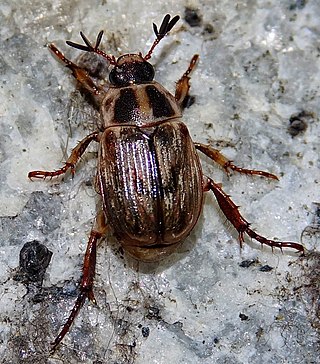
Anomala orientalis, also known as the oriental beetle (OB), is a species of Rutelinae in the family Scarabaeidae. It is a beetle about 0.7 - 1.1 cm long, with mottled, metallic brown- and black-colored elytra and a similarly colored thorax and head during the adult stage. It is sometimes confused with the larger and more colorful Japanese beetle. During the larval stage, the oriental beetle can be identified by the parallel line raster pattern.

The New Zealand giraffe weevil, Lasiorhynchus barbicornis, is a straight-snouted weevil in the subfamily Brentinae, endemic to New Zealand. L. barbicornis is New Zealand's longest beetle, and shows extreme sexual dimorphism: males measure up to 90mm, and females 50mm, although there is an extreme range of body sizes in both sexes. In males, the elongated snout can be nearly as long as the body. Male giraffe weevils use this long rostrum to battle over females, although small males can avoid conflict and 'sneak' in to mate with females, sometimes under the noses of large males. The larval weevils tunnel into wood for at least two years before emerging, and live for only a few weeks as adults.

Clytus arietis, the wasp beetle, is a wasp-mimicking longhorn beetle species in the genus Clytus.

Oiceoptoma noveboracense is a member of the family Silphidae, or carrion beetles, which feed on decaying organic matter such as dead animals. Its common name is the margined carrion beetle, from the orange-red margins on the pronotum, which are helpful when identifying this species. The larva is typically light brown to red and also has vertical ridges on its thorax like the adult. This diurnal beetle can be found mainly in the spring into the fall, and it has a strong preference towards a deciduous forest habitat. The primary forensic importance of this beetle is its ability to use the succession of insect fauna to provide confirmation of postmortem intervals.

The Rosenberg's monitor is an Australian species of varanid reptile found in southern regions of the continent. They are large and fast predators with rugged bodies and long tails, having a combined length up to 1.5 metres, that will consume any smaller animal that is pursued and captured or found while foraging. They occur in the Australian Capital Territory, New South Wales, South Australia, Victoria, where it may be rare or locally common, and more frequently observed in Western Australia, where it is sometimes abundant.
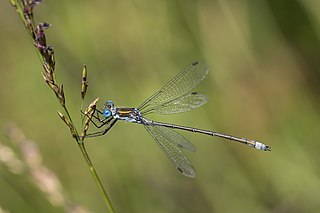
Lestes sponsa is a damselfly with a wide Palaearctic distribution. It is known commonly as the emerald damselfly or common spreadwing. Both males and females have a metallic green colour and brown wing spots. It resides near pools with aquatic plants. When resting its wings are usually half opened.
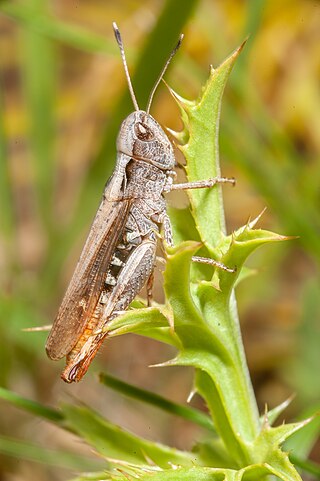
The rufous grasshopper is a species of grasshopper. It is a medium-sized, broad, brown, short-horned grasshopper with clubbed antennae that are tipped with a conspicuous white or pale colour. It is fairly large, averaging 14 to 22 mm in length. It is of the subfamily Gomphocerinae in the family Acrididae, the predominant family of grasshoppers. This species is present in most of Europe, in the eastern Palearctic realm, and in the Near East. It can be encountered from late July through mid-December, usually in dry or slightly moist habitats. The environments in which it typically resides include dry grassland on calcareous soils, sheltered valleys with scrub, and the open borders of forests. It feeds on grasses and various herbaceous plants. It is known for its distinctive courtship song and accompanying display.
Polygyny is a mating system in which one male lives and mates with multiple females but each female only mates with a few males. Systems where several females mate with several males are defined either as promiscuity or polygynandry. Lek mating is frequently regarded as a form of polygyny, because one male mates with many females, but lek-based mating systems differ in that the male has no attachment to the females with whom he mates, and that mating females lack attachment to one another.
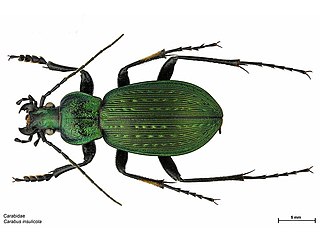
Carabus insulicola is a species of black-colored beetle from the family Carabidae native to Japan. They are also known as ground beetles, and are oval shaped and elongated. They are black with a green metallic hue and vertical stripes running down their backs. The length of a fully grown beetle ranges from 27 to 31 mm. They have three pairs of legs and two pairs of wings. The outer wings are greatly degenerated, making them unable to fly. However, their relatively long legs allow them to walk and run fast. They have prominent mandibles that allow them to capture and eat prey.

Bolitotherus cornutus is a North American species of darkling beetle known as the horned fungus beetle or forked fungus beetle. All of its life stages are associated with the fruiting bodies of a wood-decaying shelf fungus, commonly Ganoderma applanatum, Ganoderma tsugae, and Ganoderma lucidum.

Hylobittacus apicalis is a species of hangingfly in the order Mecoptera, and the only species within the genus Hylobittacus.
Sexual coercion among animals is the use of violence, threats, harassment, and other tactics to help them forcefully copulate. Such behavior has been compared to sexual assault, including rape, among humans.

Animal non-reproductive sexual behavior encompasses sexual activities that non-human animals participate in which do not lead to the reproduction of the species. Although procreation continues to be the primary explanation for sexual behavior in animals, recent observations on animal behavior have given alternative reasons for the engagement in sexual activities by animals. Animals have been observed to engage in sex for social interaction bonding, exchange for significant materials, affection, mentorship pairings, sexual enjoyment, or as demonstration of social rank. Observed non-procreative sexual activities include non-copulatory mounting, oral sex, genital stimulation, anal stimulation, interspecies mating, same-sex sexual interaction, and acts of affection, although it is doubted that they have done this since the beginning of their existence. There have also been observations of sex with cub participants, as well as sex with dead animals.

Coprophanaeus ensifer is a large South American species of beetle belonging to the family Scarabaeidae. This species is necrophagous and builds burrows near or on animal carcasses to dismember the flesh of decaying bodies and bring it to its burrow to feed. Both females and males help build the burrow and feed. It is characterized by its iridescent colors and a horn that is similar in shape and size in females and males. It uses its horn to tear apart carcasses and to fight with other individuals, with male-male fighting occurring more often. However, females also fight to determine a variety of characteristics of the opposing male. This species may be of importance in forensic science due to its destructive behavior on decaying bodies, especially in areas of Brazil where homicide rates are high.
Cryptic female choice is a form of mate choice which occurs both in pre and post copulatory circumstances when females in certain species use physical or chemical mechanisms to control a male's success of fertilizing their ova or ovum; i.e. by selecting whether sperm are successful in fertilizing their eggs or not. It occurs in internally-fertilizing species and involves differential use of sperm by females when sperm are available in the reproductive tract.

Augochlora pura is a solitary sweat bee found primarily in the Eastern United States. It is known for its bright green color and its tendency to forage on a variety of plants. Inhabiting rotting logs, this bee can produce up to three generations per year. Both males and females have been observed licking sweat from human skin, most likely seeking salt

Meloe americanus is a type of blister beetle (Meloidae) found in North America. It is most relevant to the fields of agriculture and veterinary medicine. Adult beetles feed on different types of plants, which cause crop damage. They also release a fluid containing a chemical that is toxic, and at high concentrations lethal, to mammals. The first instar larvae are uniquely active and mobile, utilizing phoresy and parasitism to feed and mature through their developmental stages.
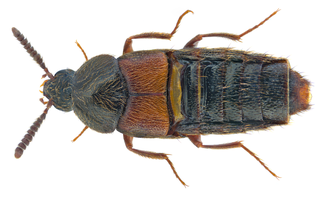
Aleochara curtula is a species of rove beetle in the family Staphylinidae. They are commonly known as Shortened Minute Rove Beetle. This beetle is found in Europe, Northern Asia and North America.
















